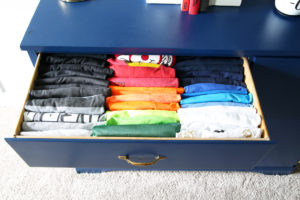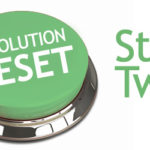For a long and valid list of reasons, I never learned to put away clean laundry during my first two decades of life.
Did anyone ever put away any laundry during college at all?
While I definitely made sure to have a washer and dryer in my every place of residence after graduation, and I regularly washed my clothes, they still somehow didn’t make it out of their basket/heap/tower and into the drawers/closet/organizers.
That brief backstory that spans over 30 years is…

Step 1 of forming a new habit: the old behavior that isn’t working for you.
My clean clothes lived in the laundry basket, sometimes folded, sometimes not, and I had to rummage and hunt to find what I wanted. I spent far more time pawing through the basket than I would have needed to put the laundry away. I couldn’t always locate a matching sock or the right black t-shirt. When I had a cat, she sometimes slept on my (now formerly) clean clothes. This part wasn’t failure; it was the life I needed to live in order to get me to the next step.
Step 2: enough is enough.
It took a looong time, but I finally got fed up with the search, the fur, and the I-don’t-have-anything-to-wear-because-I-can’t-see-what-I-have. It’s not like I never put my laundry away during those 30+ years, but I wasn’t consistent, and I usually waited until I had 5-6 clean loads to fold (because the basket could literally hold no more than that), which took me an hour and made me never want to wear or wash clothes again.
Step 3: starting the change with any action.
I knew how to fold my clothes and place them into drawers, but I didn’t do it regularly. I was like:
- I’m too busy
- I hate this
- My hands hurt when I fold and hang clothes
- There’s nowhere to put anything
- Why put it away when I’m just going to get it out again
Step 4+: handling roadblocks.
I tried a lot of organizing method and solutions that mostly involved buying things. I traded plastic hangers for wooden ones, I tried a bunch of drawer systems and dividers, and I installed countless racks and specialty hanger doodads. I learned a little each time, but I still struggled with “nowhere to put anything” and “why bother”.
I had my first of three breakthroughs when I saw a video of the Konmari folding method for t-shirts. My Zumba shirt drawer was a neon sea of chaos at the time; I had literally given up on folding them and just packed the drawer through whatever means necessary. It took me less than 30 minutes to fold my shirts, and they all (just) fit into their existing space. I could see each shirt clearly, which meant that I wouldn’t have to pull out five pink shirts every time I got dressed in order to find the pink one with the black logo and not the pink one with the yellow logo.
So I dove right in and folded the rest of my clothes Konmari style, and they’ve stayed that way ever since!
Nope. I stopped there with my one REALLY organized drawer and let disorder reign over the other drawers, the closet, and the basket system for another year.

Still on step 4.
The experience of using my organized Zumba shirt drawer did leave me thinking about how nice it would be to get dressed without so much rooting around, and that did cause me to start folding things correctly when I took the time to put them away…which was still in big binges every few weeks/months. Even when folded correctly, some categories of my clothing overflowed their storage spaces.
Since Konmari folding had worked so well for me, I decided to look into the rest of Marie Kondo’s superb method for organizing alllll of your stuff. I took the plunge and put all of my clothes into one big pile, sorted, felt joy or not, etc. according to her recommendations. Breakthrough #2 popped up: I didn’t mind folding what was left! Although I had reduced my clothes collection by over 50%, it wasn’t the smaller pile that made me want to fold – it was that I had gotten rid of the stuff I didn’t want to put away anymore. I was tired of wearing, washing, and processing clothes that didn’t “spark joy”, but I was holding on to them for the same strange collection of reasons for which we all do things that don’t really serve us.
Last part of step 4, honest.
I fixed “I hate this” and “there’s nowhere to put anything”, and “why bother” was what had kicked off the whole set of changes with my better-functioning drawer, but I was still up against the compelling “I’m too busy”. Another year later (I wish I was exaggerating!) I hit breakthrough #3 and changed my definition of putting away the laundry.
Did you know that you don’t have to wait until the basket is heaped to twice its height before you fold its contents?
I started putting away each load as soon as it finished drying, which took me no more than 10 minutes per load (but usually closer to 4, like a single song’s worth of time), and I put the laundry baskets out of service.
Nearly a year later, I am still on my game and the baskets are empty!
Step 5: maintenance.
When I get busy, the baskets fill back up…but only with 2 loads, tops. I get appropriately frustrated and make time to put things away as I can, whether I set aside 10 minutes or just take 3 things off the top and put them away each time I pass the pile.
I still have to think about the whole laundry process a little. I have to neaten a drawer every month or so, but I don’t have to re-fold most of it. I have to keep an eye on my clothes shopping and make sure I don’t overfill any category. I have to let things be easy and not overcongratulate myself for this basic activity since I’m doing this to keep my life great and not because it’s some kind of terrible burden that I must face.
In other words, it’s not automatic, but it all stays on track in daily life, and when something throws my system off I can get back to it within 3-5 days…and I want to get back to it because it saves me time and makes me feel great to have my clean clothes set up nicely.
I don’t spend any time thinking “why didn’t you just do this sooner?”, because unless I acquire a time machine it doesn’t really matter why I didn’t/wouldn’t/couldn’t change sooner…it’s just great that I finally did what I needed to do in order to get where I wanted to be!
The moral of the story…
I’m quitting fitness to become a housekeeper! I won’t even bother with that joke because it took me over 30 years to get over putting away my laundry.
I didn’t make this change or create this habit* overnight. It didn’t take some magic pill or any difficult work; I just had to want to change, and be willing to address my own personal roadblocks that had kept me stuck living from basket to basket.
However long you’ve been wandering in the woods, whether they are laundry woods or the health and fitness forest, you can always make a change when you decide to!
Maybe you’re like I was…
- I hate this
- I’m too busy
- Getting started on something new is humbling/scary/frustrating
- Why bother working out when “it won’t work for me”
- I don’t know why I can’t just do this simple thing
Building a new habit, like folding clothes or being active, won’t become automatic overnight, but once you get a sustainable practice started (and stop being a sporadic over-doer), you will be able to chip away at each of your roadblocks and connect with all of the happiness and other benefits that are just on the other side!
You might have to change your definition of working out, and you’ll probably have to shed some things that only bring you negative feelings (sometimes the scale, a certain workout buddy, a magazine’s ideas, your own inner voice…), but if you hold on to your inspiration and vision you will certainly go far, one step at a time.
*I don’t necessarily believe that habits exist in the sense that our new actions become totally effortless and automatic, but I do believe in repeated actions that form the fabric of our daily lives, and in the idea that those actions should be easy, simple, and enjoyable.


Great Post!.. so True!!. Now to start thinking about my horizontal surface problem!